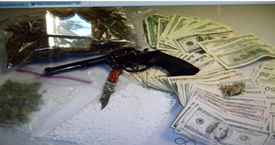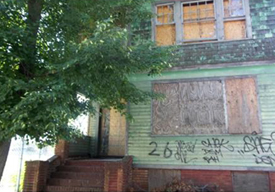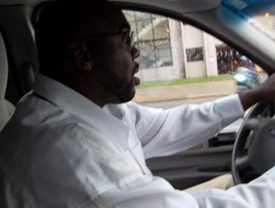These were her challenges growing up in Newark after her mother passed away when she was barely a teenager. She fell for the wrong guy, fell in with the wrong crowd, and had a baby at 15. She survived by selling drugs and dealing with guns.
“This is what I used to clock in and clock out of,’’ Gonzalez said pointing to the picture. “I met my man. This was our lifestyle … our everyday earnings.’’
She blew up the picture and hung it near her front door. After serving two terms in jail, it’s a reminder of a life she struggles to leave behind.
“I look at the picture and I look at my son – and I am not going back,’’ said Gonzalez, whose photo was included in a recent exhibit at the University Club on the Newark Campus.
Gonzalez is one of 10 former inmates who were given cameras to document the challenges they face re-entering the community. The “photo voice” project is run by Liliane Windsor, an assistant professor at the Rutgers School of Social Work in New Brunswick, whose research focuses on improving the criminal justice system. The photo exhibit will be on display at the Paul Robeson Galleries on the Newark Campus through July 25.
The project grew out of Windsor’s ongoing research that aims to change the way society views and handles crime. She is working to develop a new approach to help people who had been incarcerated rejoin the community. Her research is supported by Rutgers’ Center for Behavioral Health Services & Criminal Justice Research, which is funded by a grant from the National Institute on Mental Health.
Windsor says the current system focuses on punishment, is expensive, unfair, and doesn’t work: nationally, about 60 percent of inmates return to prison after they are released. It also doesn’t take into account oppression as an important root cause of the cycle. People born into poverty are more likely to be minorities who struggle to meet their basic needs while being exposed to violence, and discrimination. These individuals have fewer opportunities to obtain quality education and meaningful jobs and are more likely to be arrested and convicted for a crime than their White and wealthy counterparts, Windsor said.
The program Windsor is developing with assistance from other social services organizations tries to help people who had been incarcerated understand the impact of the environment on their beliefs and behavior, especially when it comes to drug use, high-risk activities, and reoffending. The second phase aims to empower former inmates by connecting them to organizations and individuals in their communities. This helps them develop the tools they need to improve their neighborhoods and address the issues they are passionate about.Windsor had been working with the Newark Community Collaborative Board to develop the new program. But board members soon realized they needed more information about the experiences of people who had been incarcerated, which became the catalyst for the photo voice project.
About half of the 10 former inmates who volunteered for the program participated in the recent photo exhibit. They shared pictures of boarded up homes, their counselors, centers that provided them with help, and other places in their communities. The former inmates talked about the need for housing, the cost and difficulty of acquiring identification and copies of their birth certificates - which are often lost when they go to prison. They also shared frustration that a drug conviction excludes them from the services they need and a criminal record makes it harder to find a job.
“When you are incarcerated they give you this big perfect picture that once you come home you go here, you go there’’ to find help, Gonzalez said. “But when you go here, you go there, it’s not there.’’
Thomas Green, who served 22 years before his conviction was overturned, talked about the challenge of finding housing. He shared a photograph of a boarded up home. Someone he knew in prison had lived there, he said.
“This is what we have to come home to,’’ he said. “If you got no place to live, you got no family, that’s it,’’ he said.
Green and Gonzalez both had family willing to help when they got out of prison. Gonzalez returned to the same neighborhood she lived in before, but was able to stay with her cousin. Green shared a photograph of himself driving to a job interview in his wife’s car. If he didn’t have family willing to help with transportation, it would have been much harder to find work.Nancy Wolff, who is working with Windsor and is the director of the Rutgers’ Center for Behavioral Health Services & Criminal Justice Research, said the photo voice project provides valuable perspective.
“We cannot really understand social problems or individual problems without talking to the individuals who actually lived those experiences,’’ Wolff said.
“That is why I think Dr. Windsor’s work is so important,’’ she said. “Because we are going to the first person and asking them to help us to understand what it is like to experience re-entry so we can respond to real people and not a cardboard understanding of re-entry and what people re-entering may need.’’





